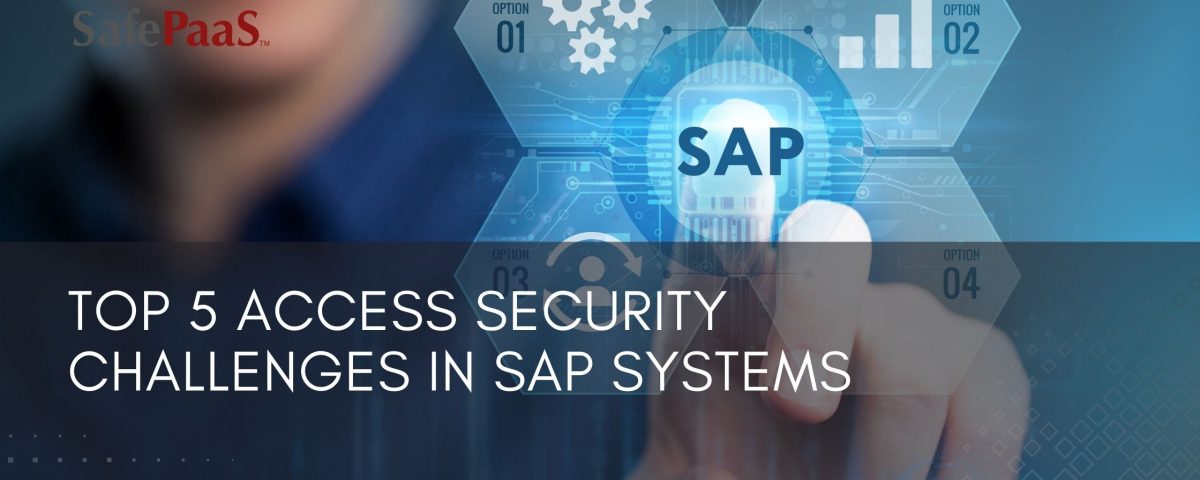Top 5 Access Security Challenges in SAP


Top 5 Access Security Challenges in SAP
Here are five high-level challenges that SAP users commonly face when it comes to securing access:
1. Complexity of Authorization Models:
SAP ECC:
In SAP ECC, the role-based access control system involves the creation of complex roles and profiles. Users may struggle with understanding the relationships between roles and how they affect access permissions.
Role proliferation is a common challenge, where numerous roles are created over time, leading to potential redundancy or conflicts in permissions.
SAP S/4 HANA:
SAP S/4 HANA introduces a more fine-grained access control model with multiple layers, including schemas, packages, and analytical privileges. Managing and understanding these layers can be intricate.
Defining and maintaining appropriate HANA database privileges requires a deep understanding of the database structure, making it challenging for administrators to ensure proper access.
SAP systems often have complex authorization models with numerous roles, profiles, and permissions. Managing and understanding these models can be challenging, leading to the risk of excessive privileges or insufficient access for users. Balancing the need for user access with the principle of least privilege becomes a complex task.
2. User Lifecycle Management:
Efficiently managing the entire user lifecycle, from onboarding to role changes and offboarding, is a significant challenge. It involves coordinating with HR processes and other systems to ensure that users have the right level of access at all times. Failing to promptly revoke access for departing employees can result in security vulnerabilities.
SAP ECC:
Managing user roles in SAP ECC during personnel changes, such as promotions, transfers, or terminations, can be time-consuming and error-prone. Delays in updating access permissions may lead to security risks.
Integrating SAP ECC with HR systems for seamless user provisioning and deprovisioning can be challenging due to system compatibility issues.
SAP HANA:
SAP HANA user lifecycle management involves not only ECC roles but also HANA-specific roles and privileges. Coordinating these across different systems can be complex.
Automating the synchronization of user data between HANA and other systems may present challenges, especially in heterogeneous IT landscapes.
3. Emergency Access and Firefighting:
Emergency access, often granted to users for troubleshooting or critical system tasks, poses a challenge in terms of control and monitoring. Unauthorized or unmonitored emergency access can lead to potential misuse or unauthorized changes. Managing and auditing such access is essential for maintaining security and compliance.
SAP ECC:
Providing emergency access in SAP ECC without proper monitoring and control can lead to potential misuse or unauthorized changes. It's challenging to balance the need for quick issue resolution with maintaining security.
Auditing and logging the activities performed during emergency access can be complex, making it difficult to track changes effectively.
SAP HANA:
Granting and managing emergency access in SAP HANA may involve dealing with both database and application-layer permissions, requiring careful coordination.
Ensuring that emergency access is only granted to authorized personnel and is regularly reviewed poses a challenge in HANA environments.
4. Integration with Identity Management Systems:
Integrating SAP access controls with broader identity and access management (IAM) systems can be complex. The challenge lies in maintaining synchronization between SAP user roles and permissions and those managed in the overarching IAM system. Inconsistencies may arise, leading to security gaps and difficulties in enforcing consistent access policies.
SAP ECC:
Integrating SAP ECC with broader Identity and Access Management (IAM) systems may involve compatibility challenges, especially in environments with diverse applications and technologies.
Synchronizing user data and access policies between SAP ECC and IAM systems in real-time can be difficult, leading to discrepancies.
SAP HANA:
The integration of SAP HANA with IAM systems must account for the unique access controls specific to the HANA database. Achieving seamless synchronization requires a deep understanding of both systems.
Managing identity federation and single sign-on (SSO) across SAP HANA and other applications may require additional configuration and careful consideration of security implications.
5. Audit and Compliance:
Ensuring compliance with industry regulations and internal policies requires robust auditing capabilities. SAP systems generate extensive logs, and analyzing these logs to detect and respond to security incidents can be a daunting task. Meeting audit requirements and demonstrating adherence to compliance standards necessitates a well-organized and efficient approach to access monitoring and reporting.
SAP ECC:
Auditing user activities in SAP ECC involves analyzing extensive logs, and extracting meaningful insights can be challenging, particularly in environments with a high volume of transactions.
Ensuring that audit trails cover critical business processes and align with industry regulations poses a challenge.
SAP HANA:
Auditing in SAP HANA requires monitoring both database-level activities and application-level events. Coordinating these audits to provide a comprehensive view can be complex.
Meeting compliance requirements, such as GDPR or industry-specific standards, necessitates a thorough understanding of the data handling capabilities and controls in SAP HANA.
Addressing these challenges in SAP ECC and SAP HANA environments requires a combination of technical solutions, streamlined processes, and ongoing user education. Regular assessments and updates to security policies are essential to adapt to the evolving threat landscape and compliance standards.
Insight by Madhusudan Bansal.
Recommended Resources

Roadmap to a successful SAP S/4 HANA Migration
Without a clear migration path, effective controls ensuring business security could be compromised. To mitigate these risks and ensure a smooth transition, it's crucial to construct a comprehensive roadmap that integrates governance, risk, and compliance management from the outset.

Safeguard SAP with SafePaaS GRC
Integrating SafePaaS GRC with SAP solutions isn't just about technology; it's about people. It's about empowering your teams to become guardians of security and compliance, fostering a culture where every action is guided by a commitment to protect and preserve.

Understanding SAP Authorization
SAP authorization is based on a role-based access control (RBAC) model. In this model, users are assigned roles that correspond to their job functions, and each role is assigned the necessary authorization profiles to perform those functions.

